Railways on Romney Marsh
However, in times past, there was also a mainline service branch line to New Romney and Littlestone.

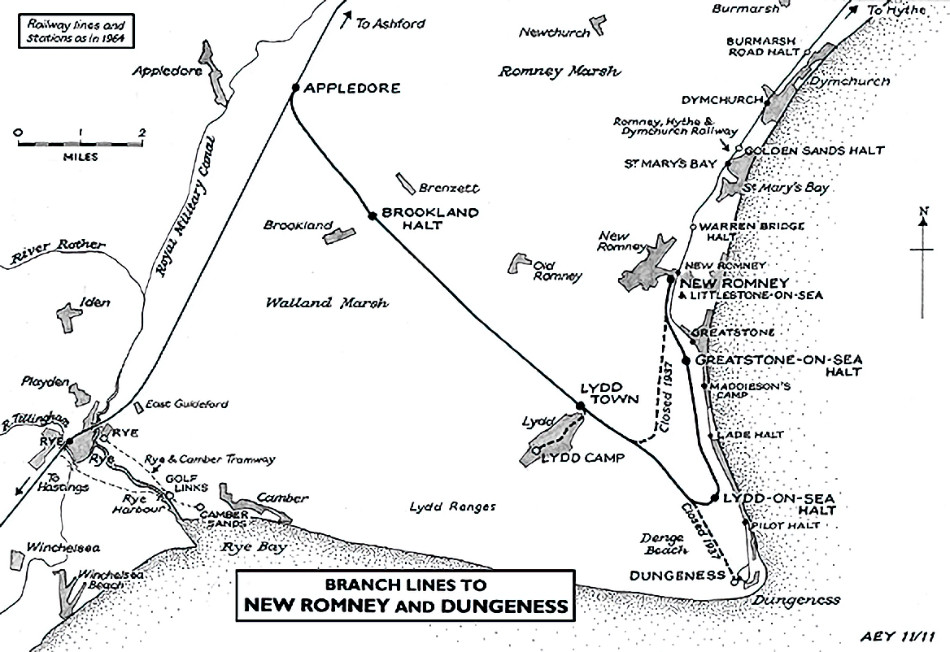
Railway lines and stations as in 1964 (Ack. 51)
Branch Lines to Dungeness and New Romney
The Ashford to Hastings main line opened on 13th February 1851 but was not profitable and gave little incentive for the South Eastern Railway to build a branch line across Romney Marsh.
Following local pressure for a branch line serving Lydd and New Romney and the possibility of a new cross channel port being developed at Dungeness, a number of schemes were proposed.
Although the Dungeness port was never built, the Lydd Railway Company obtained an Act on 8th April 1881 to build a line from the South Eastern Railway at Appledore to Dungeness, with a second act of 19th June 1882 authorising a further branch extending north along the coast to New Romney
The line opened to passengers between Appledore and Lydd on 7 December 1881, with freight services to Dungeness, until that too opened to passengers on April 1883.
The only intermediate station was at Brookland. The line had 12 level crossings in its 8 mile length.
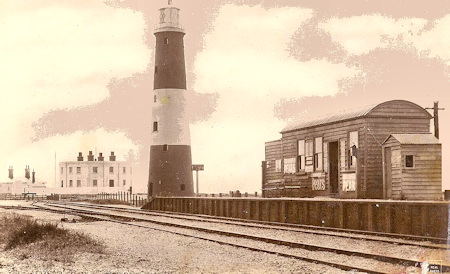
Dungeness Railway Station
The New Romney line opened on 19 June 1884 and some unusual workings were introduced with two branches being worked by one locomotive requiring some trains serving Dungeness to reverse back to Lydd Town before proceeding on to New Romney. With the Dungeness port scheme abandoned, the SER obtained powers in 1900 to extend their line to Hythe but this was never built.
With the development of military ranges and a large army camp at Lydd, the line was well used until the end of WW1. Passenger numbers were now in decline although agricultural freight, including Romney Marsh sheep, remained profitable. By the 1920s New Romney was served by 9 trains a day while Dungeness was relegated to 3.
With the increase in pleasure traffic in the 1930s and new residential and proposed holiday camp development along the coast, the New Romney branch was realigned, with a new junction one mile to the southeast with two new halts at Lydd-on-Sea and Greatstone-on-Sea. The new line opened on 4 July 1937. At the same time, the station at Lydd was renamed Lydd Town, and passenger services to Dungeness were withdrawn, although the freight service was retained.
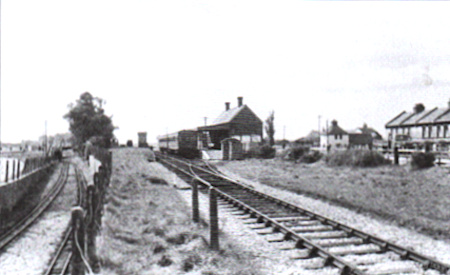
New Romney & Littlestone-on-Sea Station c1955
The line remained open with a reduced service during WW2 although an obvious target for enemy aircraft. A heavily armoured train was allocated to Ashford - Hastings - New Romney group of lines with regular patrols being undertaken.
Nationalisation in 1948 initially brought few changes but with competition from busses and the popularity of the motor car in the 1950s traffic continued to decline and economies were inevitable including the withdrawal of the Dungeness freight service in 1952 and the removal of the passing loop at Lydd-on-Sea.
In the early 1960s the line received a new use with the opening of the Dungeness Nuclear Power Station in 1965. The passenger service was improved with steam being replaced by two-car diesel-electrics providing 11 trains a day in 1962; with most running through to Ashford.
This new prosperity was not to last however and both the Ashford - Hastings line and also the New Romney branch was proposed for closure in the 1963 Beeching Report.

Lydd-on-Sea Station 1937
The goods services to New Romney was withdrawn in 1964 but the threat of closure was suspended until 1966 when the Minister of Transport announced that the passenger service on the New Romney branch would cease on 6th March 1967. The Ashford - Hastings line was however reprieved although some sections were eventually singled.
Goods services to Lydd continued until 1971 and the line was still in use for the removal of ballast aggregates and waste from Dungeness B nuclear power station. All track beyond Romney Junction has been lifted.
The only passenger movements since closure have been occasional troop trains and rail tours, the most recent being the Lydd Ranger Railtour on 13th March 2005.
![]() reference and more information text courtesy of Disused Stations
reference and more information text courtesy of Disused Stations

Lydd Station in early 1900s

The Romney, Hythe & Dymchurch Railway (RH&DR) was the culmination of the dreams of two men; Captain J. E. P. Howey — a sometimes racing driver, millionaire land owner, former Army Officer and miniature railway afficionado and Count Louis Zborowski — eminently well-known racing driver of his day (famous for owning and racing the Chitty Bang Bang Mercedes) and considerably richer, even, than Howey.
The RHyt&DR was constructed during the 1920s and opened on 16 July 1927. Zborowski had constructed a railway at Higham Park, his home at Bridge, Kent, and agreed to donate the rolling stock and infrastructure to the project.
Zborowski however was killed in a motor racing accident at Monza before the Romney Marsh site was chosen, and Howey continued the project alone.
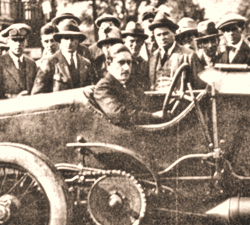
Count Louis Zborowski c1921
The RH& DR opened to traffic in 1927 as a 15" gauge (⅓ full size) fully working steam railway covering the eight miles from New Romney to Hythe. In 1928 the railway was extended southwards from New Romney through Greatstone to Dungeness, but it was reduced to a single track in 1947.
The war years took their toll, the line being requisitioned by the War Department - they even created the only miniature armoured train in the world - and was used extensively during the building of PLUTO (Pipe Line Under The Ocean) which fuelled the Allied invasion force.
The line re-opened between Hythe and New Romney in 1946, the New Romney to Dungeness section following with an opening by Laurel and Hardy on 28 March 1947.
From 7 September 1977 until 24 July 2015, the railway provided school trains to transport children to and from the Marsh Academy in New Romney. The service was finally withdrawn due to falling usage.
The railway, which carries over 150,000 passengers each year, celebrated its 80th birthday in 2007 with a week of celebrations including reconstructions of scenes on the railway from the previous eight decades.
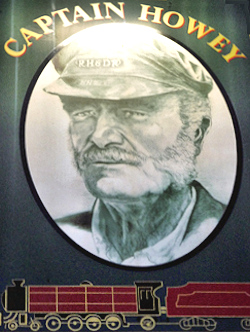
Captain Howey



















